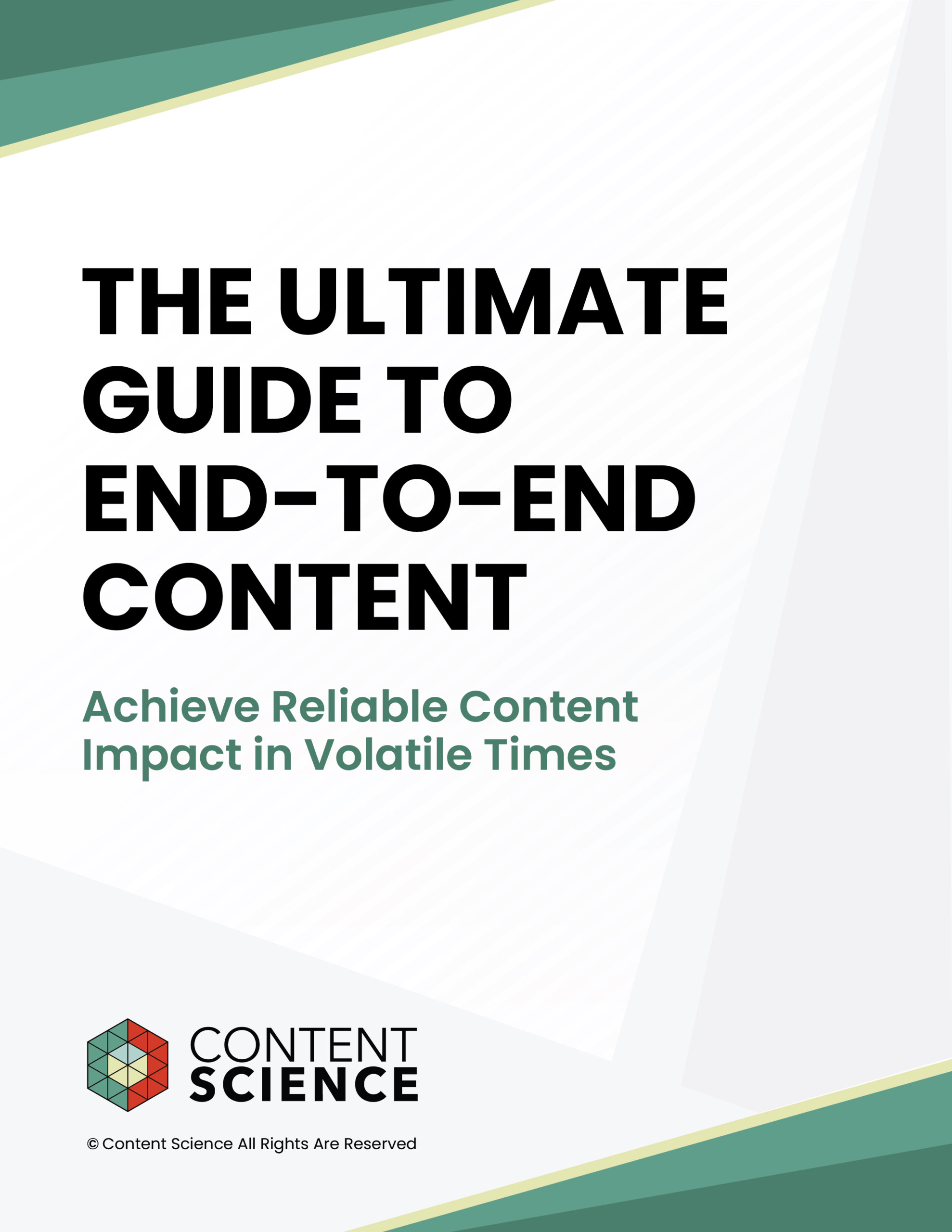
A recent MIT report revealed a sobering reality: 95% of organizations are not realizing ROI from their $30-40 billion investment in artificial intelligence(AI). Despite headlines about generative AI breakthroughs, most leaders are struggling to see measurable business benefits.
Why? The short answer: AI is different from previous digital transformations. Unlike past drivers like cloud computing or mobile, AI abstracts complexity in unprecedented ways. And generative AI is uniquely dependent on content as both input and output, which makes success or failure hinge on how an enterprise handles content.
From our research at Content Science and our experience with diverse clients, we see seven reasons organizations fail to realize AI ROI. The good news? Each has some clear steps forward.
1. Repeating Past Digital Transformation Mistakes
History shows us that digital transformation is hard: Up to 69% of initiatives have failed due to missteps like myopic focus on technology, lack of vision, poor planning, or ignoring customer adoption. Unfortunately, many organizations are repeating those same mistakes with AI.
For example, Sitecore rolled out a composable cloud CMS with little customer education or communication. The backlash was swift—public complaints, frustrated users, and ultimately a failed attempt to make Gartner’s Magic Quadrant.
What to Do Instead:
- Lead with a vision, not a tool or technology. Successful AI transformation, such as Intuit’s Mailchimp evolution from email tool into $12B marketing platform, integrated content, communication, and customer experience considerations.
- Engage leadership beyond the CIO. CEOs, CMOs, and, of course, Chief Content Officers or their equivalent must champion AI as a business strategy, not just a technology upgrade.
- Empower your customers and employees. Adoption doesn’t happen by accident—it requires comprehensive planning of and communication throughout customer experiences and employee experiences.
2. Underestimating AI Uncertainty and Risk
AI introduces unprecedented unknowns. Unlike a CRM, CMS, DAM, or ERP rollout, the outcomes of AI systems aren’t always predictable. CIO Magazine recently reported that in the manufacturing industry alone security concerns with AI have tripled, accuracy worries have grown fivefold, and transparency issues quadrupled.
From IP leaks to inaccuracies and hallucinations, organizations are rightly concerned. But freezing AI adoption entirely means missing opportunities competitors are seizing and risking obsoletion. From the year 2003 to 2023, 52% of the Fortune 500 disappeared, largely due to rapidly changing technology and business models.
What to Do Instead:
- Proactively manage risks. Establish guardrails around transparency, bias, copyright/IP, and sustainability.
- Prioritize measurement. Don’t just measure efficiency gains; measure whether AI-generated content is accurate, relevant, and trustworthy. For instance, Pfizer cut GTM content production time by 50% while still maintaining reuse and alignment across workflows.
- Embrace governance, not guesswork. Enterprises like Bank of America built trust by training their AI assistant on a human-reviewed knowledge base, blending automation with oversight.
3. Perpetuating Content Immaturity and Debt
Here’s the uncomfortable truth: most organizations’ content operations aren’t ready for AI. Our research todate shows 58% of enterprises are at level 1 or 2 maturity—still stuck in chaotic or piloting stages. That immaturity becomes a bottleneck for scaling AI.
Think of AI as a high-performance car. If your roads (content workflows) are full of potholes and dead ends, the car won’t get you far.
We’ve seen organizations succeed by investing in workflows and governance first. Cedars-Sinai, for example, ensured AI supported—not replaced—clinicians in their triage system, improving throughput with safety and trust intact.
What to Do Instead:
- Audit your content operations. Identify outdated assets, fragmented systems, and governance gaps.
- Invest in maturity. Move from chaotic to scaling, sustaining, and thriving by standardizing workflows, defining roles, and aligning across teams.
- Treat content debt seriously. Just as financial debt limits agility, content debt drags AI ROI down. Identify issues such as poorly structured content, lack of taxonomy or metadata standards, outdated content, and out-of-compliance content so you can resolve them.
4. Focusing Only on Efficiency, Not Effectiveness
Many enterprises approach AI with a narrow goal: “How much faster can we produce content?” While speed matters, it’s only part of ROI. If the content is inaccurate, irrelevant, or fails to influence decisions, faster production just means faster failure.
For instance, Air Canada’s chatbot generated fake policies to give quick answers, ultimately resulting in legal action against the airline. A textbook case of efficiency without effectiveness.
What to Do Instead:
- Redefine ROI. Measure not just efficiency (time saved) but also effectiveness (impact on customer behavior, satisfaction, and trust and impact on business goals).
- Use a multidimensional framework. At Content Science, we evaluate content effectiveness across dimensions like discovery, accuracy, relevance, usefulness, and influence. AI-generated content must be held to the same standard.
- Pilot with purpose. Walmart’s My Assistant showed productivity gains but also governance needs. Small-scale pilots can surface these risks before scaling.
5. Ignoring the End-to-End Content Lifecycle
AI doesn’t start and stop at content creation. It touches every stage of the content lifecycle—from strategy and modeling to governance, training, measurement, and optimization across every phase of the customer journey. Yet too many organizations limit their AI experiments to one-off pilots in marketing or customer service.
Success stories like Novo Nordisk (cutting regulatory document drafting from 12 weeks to 15 minutes) or Anthropologie (boosting engagement with AI-driven personalization) came not from isolated tools but from integrated, end-to-end approaches.
What to Do Instead:
- Adopt an E2E content approach. Align strategy, operations, data, and systems across the content lifecycle and the customer journey. We call this approach the 6 Ps: Problem, Plan, Persuasion, Power to Scale, Prudence, and Perseverance.
- Think beyond silos. Content must connect marketing, product, customer support, and employee experience.
- Treat AI as content-led, not tech-led. Or as we often say: AI may drive transformation, but content must lead it.
6. Focusing on the Wrong Use Cases for AI
Many organizations rush straight to content generation as their first AI use case. On the surface, it seems like the fastest way to demonstrate AI ROI: Crank out articles, campaigns, emails, or product descriptions more quickly. But in reality, content generation is one of the riskiest and most challenging AI applications.
Why? See number two above and also note:
- Accuracy, quality, and trustworthiness are harder to guarantee. AI-generated content can “hallucinate,” introduce bias, or spread misinformation.
- Copyright and IP concerns remain unresolved. Using AI to generate content without safeguards risks leaking your own IP—or infringing on others’.
- Customer backlash is real. When customers discover content that feels off-brand, incorrect, or inauthentic, confidence erodes fast.
By contrast, other AI use cases can be less risky and more immediately impactful. AI can enhance content analysis by identifying gaps, redundancies, and opportunities in massive ecosystems. It can help engineer personalization at scale, tailoring messages and visuals to audiences with precision. It can strengthen governance by enforcing consistency and compliance as well as helping resolve content debt. And it can advance content measurement and intelligence, surfacing insights about effectiveness that humans alone might miss.
In other words, consider whether ROI can come faster when AI isn’t asked to replace human content creation, but to augment the intelligence, governance, and impact of your content systems.
What to Do Instead:
- Balance your portfolio of AI use cases. Don’t let generative AI experiments dominate at the expense of more stable, proven applications.
- Prioritize “low-risk, high-impact” areas. Content analysis, personalization, governance, translation / localization, and measurement often deliver faster ROI with fewer pitfalls.
- Treat content generation as an advanced use case. Tackle it once you have governance, maturity, and trust frameworks in place.
7. Building Instead of Buying
Another major obstacle is the temptation to build AI solutions in-house, even when proven, off-the-shelf tools imbued with AI exist. That same MIT study we mentioned earlier also found internal builds of AI solutions fail twice as often. This aligns with broader industry observations collected by Andreessen Horowitz that as the AI ecosystem matures, enterprises are increasingly choosing to buy rather than build.
Why is buying often smarter?
- Vendor tools embed domain expertise. AI-infused products—from content analytics platforms to content management systems to personalization engines—already solve for real-world use cases and factor in best practices.
- Faster deployment and ROI. Ready-made tools typically implement faster and deliver tangible value sooner—vital given ROI timelines most organizations face.
- Lower maintenance burden. Unlike custom systems that require long-term model retraining, infrastructure, and upkeep, vendor solutions offload that burden.
But “buy” does not mean “lock in blindly.” The best path forward is to balance build and buy.
- Buy when AI use cases are well understood and established—like personalization, compliance monitoring, or measuring effectiveness.
- Build selectively when true differentiation, proprietary data advantage, or competitive positioning justifies the investment—and only once your content operations and governance are mature.
What to do instead:
- Map your AI use cases. Determine which are commodity (best bought) versus strategic (justifying custom build).
- Prioritize speed to value. Start with vendor tools to deliver quick wins and build internal capacity.
- Evolve thoughtfully. As your AI maturity grows, selectively layer custom capabilities atop proven platforms.
The MIT report is a wake-up call: AI won’t magically deliver ROI. Success requires avoiding old mistakes, managing new risks, maturing content operations, measuring effectiveness (not just efficiency), and embracing an end-to-end content approach.
Enterprises that do this are already seeing measurable returns—from the time it takes to draft regulatory documents cut by 99% for Novo Nordisk, to GTM content production accelerated by 50% for Pfizer, to millions of advisor hours saved for Merrill Lynch. And that’s only the start of possible rewards.
Enterprises who don’t follow suit risk wasted investment, reputational damage, or worse. In the era of AI, the organizations that thrive will be the ones that realize a simple but powerful truth: AI transformation is driven by technology, but it must be led by content. If even a third of that $30-40 billion investment had gone toward content leadership, strategy, and operations, we’d see much more progress in enterprise adoption of AI—and much higher returns.
Events, Resources, + More
The Ultimate Guide to End-to-End Content
Discover why + how an end-to-end approach is critical in the age of AI with this comprehensive white paper.
The Content Advantage Book
The much-anticipated third edition of the highly rated book by Colleen Jones is available at book retailers worldwide. Learn more!
20 Signs of a Content Problem in a High-Stakes Initiative
Use this white paper to diagnose the problem so you can achieve the right solution faster.
Upskill with Content Science Academy
Training for modern content roles through on-demand certifications + courses or live workshops.







Comments
We invite you to share your perspective in a constructive way. To comment, please sign in or register. Our moderating team will review all comments and may edit them for clarity. Our team also may delete comments that are off-topic or disrespectful. All postings become the property of
Content Science Review.